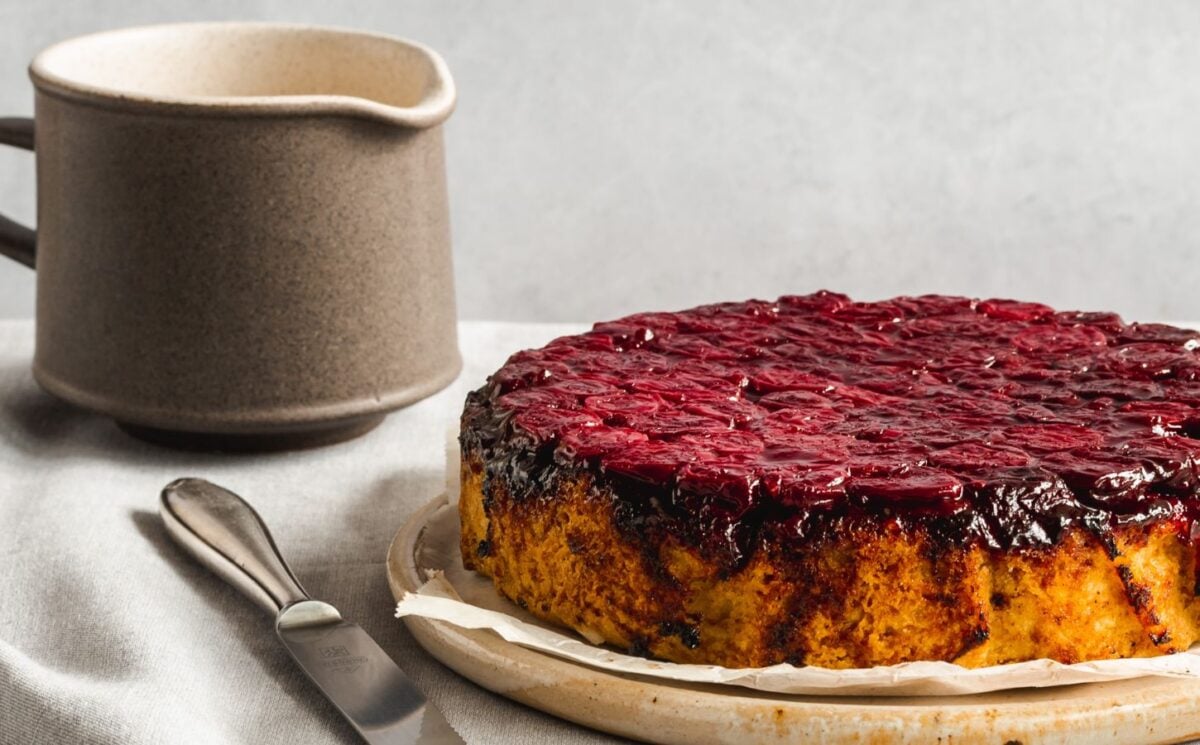Pork Chops with Strawberries and Port. Justin Tsucalas/photos; Lisa Cherkasky/food styling, for The Washington Post I associate berries with the summer months. But in reality, strawberry season typically starts in late spring, and as early as February in some parts of the country.
So the time to start enjoying the crimson fruit is ...

*checks calendar* ...
now. A ripe strawberry can shine on its own, requiring only a quick rinse before I grab it by its leaves and take a big bite. When I do cook with the fruit — either because of less-than-perfect specimens, an abundance of berries that I need to make use of or a desire to experiment in the kitchen — I’m inclined to play up its sweetness by mixing it with sugar in a dessert.
But on the other side of strawberry’s saccharine quality is a tartness that offers balance and makes it a welcome addition in savory recipes, too. A pan sauce is a great place to start. Here, strawberries mix with port wine, ginger and black pepper to accompany simply seasoned and seared pork chops.
The recipe starts with thick-cut, bone-in pork chops that are patted dry and sprinkled all over with salt and pepper. When eating the meat plain, I’m a fan of searing the chops to get some good browning before basting with butter to finish them off. But with a pan sauce, I’m OK with forgoing the deep browning by cooking the pork over moderate heat and flipping them frequently, which is slightly less fussy than the other method and also leads to evenly cooked meat.
Once the chops are set aside to rest – always rest meat before cutting into it! — it’s time to make the pan sauce. With the strawberries, I like to start by washing and then hulling them, or removing the green leaves and stems. (While the leaves and stem are edible, their flavor has been described as mostly nonexistent or earthy, the texture isn’t always desired, and sometimes they’re removed purely for aesthetics.
) You could simply lop off the top of the berry and toss it to the side, but that wastes a decent amount of delicious flesh in the process. Instead, use the tip of a paring knife to cut around just the hull, leaving more berry goodness intact for you to enjoy. To hull a strawberry: Grab a sharp paring knife with your dominant hand, gripping the blade with your index finger and thumb, and leave about 1 inch poking out.
Holding the strawberry in your other hand, insert the blade into the fruit at a 45 degree angle on the top of the berry just outside where the leaves are growing. With a steady grip on the knife, rotate the blade and the fruit in opposite directions until you completely cut around the stem area. Then the hull should easily come out.
The strawberries are then quartered and added to the skillet alongside ruby port (a sweet fortified wine that generally tastes like red berries) and fresh ginger for a hint of sweet spice. Let the contents of the pan cook so that the fruits release some of their juices and the liquid reduces. Cold butter is whisked in at the end to add sheen and luscious body to the sauce before it’s finished with fresh lemon juice and a healthy dose of black pepper.
The pepper might sound like a strange addition, but it marries well with the ginger, and their combined spice — as well as the acidity from the lemon juice — help to balance the sweetness of the fruit and wine. One bite of the chop with the strawberry sauce and you’ll quickly understand why pork and fruit go so well together. The mild, savory meat is a great canvas for strawberry’s sweet-tart flavor that gets highlighted in this pan sauce.
It makes for a special-occasion-worthy main dish that takes just 40 minutes to prepare, meaning you can enjoy it any night of the week. Use the tip of a paring knife to cut around the hull of strawberries to cut down on waste. Justin Tsucalas/photos; Lisa Cherkasky/food styling, for The Washington Post Pork Chops with Strawberries and Port A sweet-savory strawberry sauce made with ruby port is the perfect match for seared pork chops.
Ginger, black pepper and lemon juice add a touch of spice to balance the fruit and fortified wine. Serve it with simply cooked green vegetables, such as sautéed green beans or steamed asparagus, and crusty bread to mop up the luscious sauce. 2 servings Two (12-ounce) center-cut, bone-in pork chops, about 1 inch thick 1/4 teaspoon fine salt, plus more as needed 1 teaspoon freshly ground black pepper, divided, plus more as needed 1 tablespoon peanut oil or other neutral oil 8 ounces strawberries, hulled and quartered (about 2 cups) 3/4 cup ruby port 1 tablespoon minced or finely grated fresh ginger 2 tablespoons cold unsalted butter, cut into pieces 1 tablespoon fresh lemon juice, plus more as needed Pat the meat dry and sprinkle all over with the salt and 1/2 teaspoon of the black pepper.
In a large (12-inch) stainless steel skillet over medium heat, heat the oil until shimmering. Add the pork chops and cook, flipping every 2 minutes, until browned on the outside and the internal temperature in the thickest part away from the bone registers 145 degrees on an instant-read thermometer, about 15 minutes. If your chops have a fat cap, use tongs to stand them up, pressing the fat cap into the skillet to render and sear until crisp, about 1 minute.
Transfer the pork chops to a cutting board, cover loosely with foil and let rest while you make the pan sauce. Add the strawberries, port and ginger to the skillet, scraping up any browned bits at the bottom of the pan. Bring to a simmer and cook, stirring occasionally, until reduced by half, 7 to 10 minutes.
Add the butter, a couple of pieces at a time, stirring constantly until the sauce emulsifies and thickens slightly, about 2 minutes. Remove from the heat, and stir in the lemon juice and the remaining 1/2 teaspoon of black pepper. Taste, and season with more salt, pepper and lemon juice, if desired.
Serve each chop with a pour of the strawberry sauce. Nutritional information per serving | 770 Calories: 22g Carbohydrates, 201mg Cholesterol, 42g Fat, 3g Fiber, 53g Protein, 16g Saturated Fat, 426mg Sodium, 13g Sugar We believe it’s important to offer commenting on certain stories as a benefit to our readers. At its best, our comments sections can be a productive platform for readers to engage with our journalism, offer thoughts on coverage and issues, and drive conversation in a respectful, solutions-based way.
It’s a form of open discourse that can be useful to our community, public officials, journalists and others. Read more..
. We do not enable comments on everything — exceptions include most crime stories, and coverage involving personal tragedy or sensitive issues that invite personal attacks instead of thoughtful discussion. For those stories that we do enable discussion, our system may hold up comments pending the approval of a moderator for several reasons, including possible violation of our guidelines.
As the Maine Trust’s digital team reviews these comments, we ask for patience. Comments are managed by our staff during regular business hours Monday through Friday and limited hours on Saturday and Sunday. Comments held for moderation outside of those hours may take longer to approve.
By joining the conversation, you are agreeing to our commenting policy and terms of use . More information is found on our FAQs . You can modify your screen name here .
Show less Please sign into your Press Herald account to participate in conversations below. If you do not have an account, you can register or subscribe . Questions? Please see our FAQs .
Your commenting screen name has been updated. Send questions/comments to the editors..
Food

Pork chops in a strawberry port sauce lean into the fruit’s savory side

Pork and fruit pair well together, and this luscious strawberry pan sauce is further proof.















